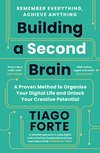Building a Second Brain: A Proven Method to Organise Your Digital Life and Unlock Your Creative Potential
amazon.com
Building a Second Brain: A Proven Method to Organise Your Digital Life and Unlock Your Creative Potential

endeavored to distill the essence of each scene into a sentence, expressing in a few words what the point of the scene was.”
There is a parallel between PARA and how kitchens are organized. Everything in a kitchen is designed and organized to support an outcome—preparing a meal as efficiently as possible. The archives are like the freezer—items are in cold storage until they are needed, which could be far into the future. Resources are like the pantry—available for use
... See moreIn this sense, notetaking is like time travel—you are sending packets of knowledge through time to your future self.
Don’t make it an analytical decision, and don’t worry about why exactly it resonates—just look inside for a feeling of pleasure, curiosity, wonder, or excitement, and let that be your signal for when it’s time to capture a passage, an image, a quote, or a fact.
see yourself as the curator of the collective thinking of your network, rather than the sole originator of ideas.
An idea wants to be shared. And, in the sharing, it becomes more complex, more interesting, and more likely to work for more people. —adrienne maree brown, writer and activist
“I believe in starting each project with a stated goal. Sometimes the goal is nothing more than a personal mantra such as ‘keep it simple’ or ‘something perfect’ or ‘economy’ to remind me of what I was thinking at the beginning if and when I lose my way. I write it down on a slip of paper and it’s the first thing that goes into the box.”
It is a way of turning up the volume on our intuition so we can hear the wisdom it offers us.
That feedback in turn gets drawn in to your Second Brain, where it becomes the starting point for the next iteration of your work.